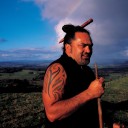
The living past
Maori art treasures are powerful links between past and present.Many are revered as living beings and cherished for the mana they embody. This article explores the legacy of Maori art and offers a tribute to a great photographer who sought to convey the vibrancy of these works.
It was appropriate that Brian Brake, New Zealand’s most celebrated ‘people photographer’, be commissioned to photograph Maori art treasures, or taonga.
To the Maori these treasures feather cloaks, canoe prows, pendants, clubs and a multitude of other artefacts — are much more than objets d’art; they are living entities which carry the mana of those who made them, handled them, and passed them on to the generations of today.
In a sense, they are ‘people’. Many have names. They are revered as if they are the ancestors they honour. They are called taonga tuku iho, the treasures handed down, and their history sometimes reaches as far back as Hawaiki, the Polynesian homeland of the Maori.
When a descendant holds one of these pieces, all the power, awe and authority of the ancestors flows into the living person. Tears flow, and a bridge is built between the living and the dead, the past and the present.
It was this sense of a living presence that so struck Americans, and later New Zealanders, who viewed the famed Te Maori exhibition between 1984 and 1987. Some of the taonga on the following pages were in that exhibition. Others have been photographed for books on Polynesian and Maori art.
In photographing these pieces, Brian Brake sought to discover what the artists who made them had intended them to show. Often he used a moving light source to mould an area he wanted to emphasise, giving it a depth that static light was unable to do.
Through the window of his own times, culture and training, Brian Brake tried to gain a vision of another culture; to see beneath the surface of the artwork to the spirit within, and to convey that vision to a wider audience. How well he succeeded is for the viewer to judge.
To te kanohi, tona kite
To te hinengaro, tona kite
To te wairua, tona kite.
The eye, the mind, the soul each has its own perspective.
















